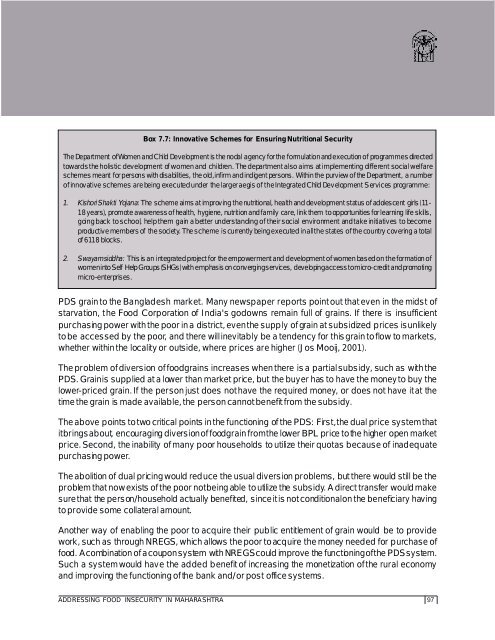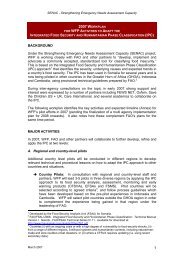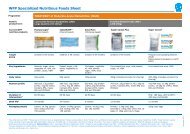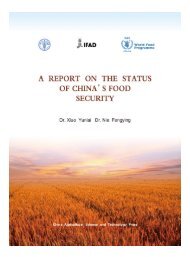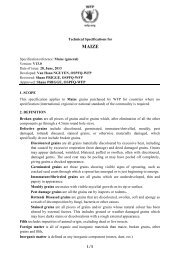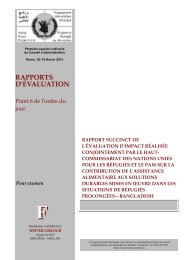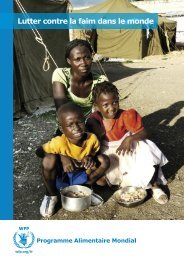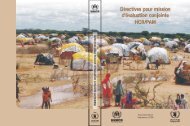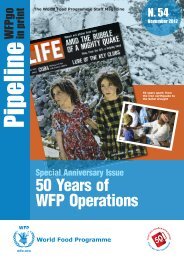Box 7.7: Innovative Schemes for Ensuring Nutritional <strong>Security</strong>The Department of Women and Child Development is the nodal agency for the formulation and execution of programmes directedtowards the holistic development of women and children. The department also aims at implementing different social welfareschemes meant for persons with disabilities, the old, infirm and indigent persons. Within the purview of the Department, a numberof innovative schemes are being executed under the larger aegis of the Integrated Child Development Services programme:1. Kishori Shakti Yojana: The scheme aims at improving the nutritional, health and development status of adolescent girls (11-18 years), promote awareness of health, hygiene, nutrition and family care, link them to opportunities for learning life skills,going back to school, help them gain a better understanding of their social environment and take initiatives to becomeproductive members of the society. The scheme is currently being executed in all the states of the country covering a totalof 6118 blocks.2. Swayamsiddha: This is an integrated project for the empowerment and development of women based on the formation ofwomen into Self Help Groups (SHGs) with emphasis on converging services, developing access to micro-credit and promotingmicro-enterprises.PDS grain to the Bangladesh market. Many newspaper reports point out that even in the midst ofstarvation, the <strong>Food</strong> Corporation of India's godowns remain full of grains. If there is insufficientpurchasing power with the poor in a district, even the supply of grain at subsidized prices is unlikelyto be accessed by the poor, and there will inevitably be a tendency for this grain to flow to markets,whether within the locality or outside, where prices are higher (Jos Mooij, 2001).The problem of diversion of foodgrains increases when there is a partial subsidy, such as with thePDS. Grain is supplied at a lower than market price, but the buyer has to have the money to buy thelower-priced grain. If the person just does not have the required money, or does not have it at thetime the grain is made available, the person cannot benefit from the subsidy.The above points to two critical points in the functioning of the PDS: First, the dual price system thatit brings about, encouraging diversion of foodgrain from the lower BPL price to the higher open marketprice. Second, the inability of many poor households to utilize their quotas because of inadequatepurchasing power.The abolition of dual pricing would reduce the usual diversion problems, but there would still be theproblem that now exists of the poor not being able to utilize the subsidy. A direct transfer would makesure that the person/household actually benefited, since it is not conditional on the beneficiary havingto provide some collateral amount.Another way of enabling the poor to acquire their public entitlement of grain would be to providework, such as through NREGS, which allows the poor to acquire the money needed for purchase offood. A combination of a coupon system with NREGS could improve the functioning of the PDS system.Such a system would have the added benefit of increasing the monetization of the rural economyand improving the functioning of the bank and/or post office systems.ADDRESSING FOOD INSECURITY IN <strong>MAHARASHTRA</strong>97
Infants and Young ChildrenBox 7.8: Meeting the Nutritional Needs of Vulnerable GroupsAccording to the National Family Health Survey 3 (NFHS-3, 2005-06), in India 40.4 per cent and 44.9 per cent of children under3 years of age are underweight and stunted, respectively. The prevalence of underweight and stunting continually increases upto the age group of 18-23 months. This indicates that there is need for improvement in complementary feeding practices, andin the quality of complementary foods fed to infants and young children. Besides the high rates of malnutrition, the infant mortalityrate is also quite high at 57 per 1,000 live births.During the first two years of life, significant cognitive development and physical growth occurs that requires adequate nutritionas well as good care practices. Damage that may occur at this early age is often irreversible and has lifetime consequences.Therefore, it is of critical importance that children receive proper nutrition in the first few years of life.In order to address the prevalence of widespread malnutrition and the high infant mortality rate that impede human development,the United Nations World <strong>Food</strong> Programme (<strong>WFP</strong>) is developing a low-cost ‘ready-to-use supplementary food’ (RUSF). Themain ingredients in the ready-to-eat food will be cereal, oil, sugar, pulse, peanut paste and milk powder. In addition, the readyto-eatfood will be fortified with an array of micronutrients and will be packaged in individual hygienic serving sachets.The food will be rigorously tested in a laboratory to ensure that it is compliant with internationally accepted standards. Next,acceptability trials will be carried out to determine how suitable the product is for the targeted beneficiaries. Finally, pilot distributionof the RUSF will be through the Integrated Child Development Services (ICDS) to infants and young children aged 6-24 monthsliving in Nabarangapur District, Orissa. During the pilot distribution, an efficacy study will be conducted to assess the impact onthe growth and micronutrient status of children receiving the RUSF compared to children receiving other foods.The above-mentioned employment-based schemes are meant to meet the needs of shorter-term oreven transient (seasonal) food insecurity. By increasing the quantities of public entitlements to foodthey can deal, to an extent, with immediate problems of hunger. If these foods are fortified, orsupplements given as in the ICDS schemes, protein and fat deficiencies could also be temporarilytackled. But any solution to food insecurity requires an increase in the regular access to food in sufficientquantity and quality. This requires an increase in the production and earning capacity of the householdsand individuals too, given that there are gender-based discriminations in the distribution of food andallied health-care services within households. It is important, therefore, that food schemes be linkedwith development activities.*****98 FOOD SECURITY ATLAS OF <strong>RURAL</strong> <strong>MAHARASHTRA</strong>
- Page 1 and 2:
Food Security AtlasOfRURAL MAHARASH
- Page 3 and 4:
Copyright © 2010The UN World Food
- Page 5 and 6:
TECHNICAL ADVISORY GROUPChairperson
- Page 8:
PrefaceIndia is home to more than a
- Page 12 and 13:
ContentsForewardPrefaceAcknowledgem
- Page 14 and 15:
List of Tables, Figures, Maps and B
- Page 16 and 17:
List of AbbreviationsADAPTAIDISAPLA
- Page 19 and 20:
Executive SummaryExecutive SummaryF
- Page 21 and 22:
capacities and knowledge.Measures t
- Page 24 and 25:
1. Introduction1. IntroductionIndia
- Page 26 and 27:
production. This portion of the con
- Page 28:
other states in the country. In lin
- Page 31 and 32:
Map 2.1: Maharashtra: Administrativ
- Page 33 and 34:
Table 2.2: Percentage Poverty Rates
- Page 35 and 36:
Table 2.6: Sectoral Composition of
- Page 37 and 38:
Table 2.8: Mortality and Nutritiona
- Page 39:
Table 2.11: Status of ConsumptionPe
- Page 42 and 43:
Children who are more than two stan
- Page 44 and 45:
Map 3.1: Food Security Outcome Map
- Page 46 and 47:
Table 3.3: Indicators used to Compu
- Page 48 and 49:
the ‘normal’ entitlements to fo
- Page 50 and 51:
to the dependent population 1 . Thi
- Page 52:
Table 3.4: Indicators Used to Analy
- Page 55 and 56:
4.2. ProductionTable 4.1: Growth of
- Page 57 and 58:
Box 4.1: Agricultural Production an
- Page 59 and 60:
Table 4.4: Extent of Irrigation in
- Page 61 and 62:
The state has a modest coverage (15
- Page 63 and 64:
Map 4.4: Status of Rural Connectivi
- Page 65 and 66:
Table 4.8: Indicators Used in Const
- Page 68 and 69:
5. Access to Food5. Access to FoodT
- Page 70 and 71:
Table 5.2: Rural Casual Wage Rate b
- Page 72 and 73: 5.3. Agricultural LabourersMaharash
- Page 74 and 75: Table 5.7: Proportion of Scheduled
- Page 76 and 77: Table 5.9: Ratio of Working Age Pop
- Page 78 and 79: Table 5.11: Rural Female Literacy b
- Page 80 and 81: poor food security situation. In Ma
- Page 82 and 83: Table 5.14: Urbanization in Maharas
- Page 84 and 85: This re gional patter n of migratio
- Page 87 and 88: 6. Food Absorption6. Food Absorptio
- Page 89: Map 6.1: Access to Health Services
- Page 92: Map 6.3: Food Absorption Map of Rur
- Page 95 and 96: Table 7.1: Ranks of Districts on Co
- Page 97 and 98: Map 7.2: Maharashtra: Priority Dist
- Page 99 and 100: e improved through better rural con
- Page 101 and 102: Box 7.1: National Policy for Farmer
- Page 103 and 104: A part of the wastelands has also b
- Page 105 and 106: development policy for forest-dwell
- Page 107 and 108: Table 7.6: Index of Public Interven
- Page 109 and 110: Table 7.7: MGNREGS Performance, All
- Page 111 and 112: Another policy implication from the
- Page 113 and 114: The list of activities taken up und
- Page 115 and 116: Box 7.5: The Forest Rights ActThe S
- Page 117 and 118: women’s land rights also increase
- Page 119 and 120: Box 7.6: Ralegan Siddhi: A Village
- Page 121: may not be a corresponding improvem
- Page 126 and 127: frequent disruption in the supply o
- Page 128 and 129: panchayats, the panchayats perform
- Page 130: Table 8.1: Key Interventions in Pri
- Page 133 and 134: Government of India (2007a), The Sc
- Page 135: Srivastava, Ravi, 1997, “Rural La
- Page 138 and 139: Thus, rights require state action w
- Page 140: obligation of the state to provide
- Page 143 and 144: Name of Variable and Description So
- Page 145 and 146: The basic objective of using PCA is
- Page 147 and 148: Appendix III: Index Value, Normativ
- Page 149 and 150: Table A3.3:Index Values and Normati
- Page 151: The Food Security Atlas of Rural Ma


